The Role of Air Mass Advection and Solar Radiation in Modulating Air Temperature Anomalies in Poland
Abstract
1. Introduction
2. Materials and Methods
2.1. Data
2.1.1. Weather Data
2.1.2. HYSPLIT
2.1.3. ERA5 Reanalysis
2.2. Data Processing
2.3. Random Forest Regressor Model
3. Results
3.1. Statistical Assessment of Air Temperature and Solar Flux Anomalies
3.2. Influence of Air Mass Transport Direction on Temperature and Solar Radiation Anomalies Across Seasons
3.3. Radiation-Driven Temperature Anomalies in Winter and Summer
3.4. Impact of Advection on Temperature Anomaly for Different Seasons
3.5. Extreme Warm and Cold Episodes
3.6. Identification of Key Factors Influencing Temperature Anomalies
4. Discussion
5. Conclusions
- The importance of air mass advection versus radiative (solar flux) factors in shaping temperature anomalies varies seasonally. Radiation dominates during warm seasons, while advection-related geographic factors prevail in winter.
- During high-positive temperature anomalies (exceeding two standard deviations), increased solar radiation (19–45%) occurs across all seasons. Conversely, summer cold anomalies coincide with strong negative solar radiation anomalies (up to −60%), whereas winter cold events may still exhibit positive radiation anomalies (81%), implying negative net radiation at the surface.
- Extreme temperature events are linked to significant radiation anomalies and altered air mass transport, with directionality dependent on the season.
- The geographic origin of air masses primarily determines anomaly type in autumn and winter. During warm seasons, positive temperature anomalies correlate predominantly with continental air masses from the east/southeast, while negative anomalies occur with marine air masses from the west/northwest. This relationship reverses in cold seasons.
- Meridional flow exerts a slightly stronger influence than zonal flow on temperature anomalies in spring and autumn. In contrast, during winter and summer—when meridional flow impact weakens—zonal circulation gains prominence in driving temperature anomalies.
- Very slow circulation over Central Europe, occurring twice as frequently in summer as in winter, causes summer positive temperature anomalies (1.2 °C) with slightly negative radiation (−2.1 W/m2) and winter negative temperature anomalies (−1.9 °C) with slightly positive radiation (0.3 W/m2).
Author Contributions
Funding
Institutional Review Board Statement
Informed Consent Statement
Data Availability Statement
Conflicts of Interest
Appendix A
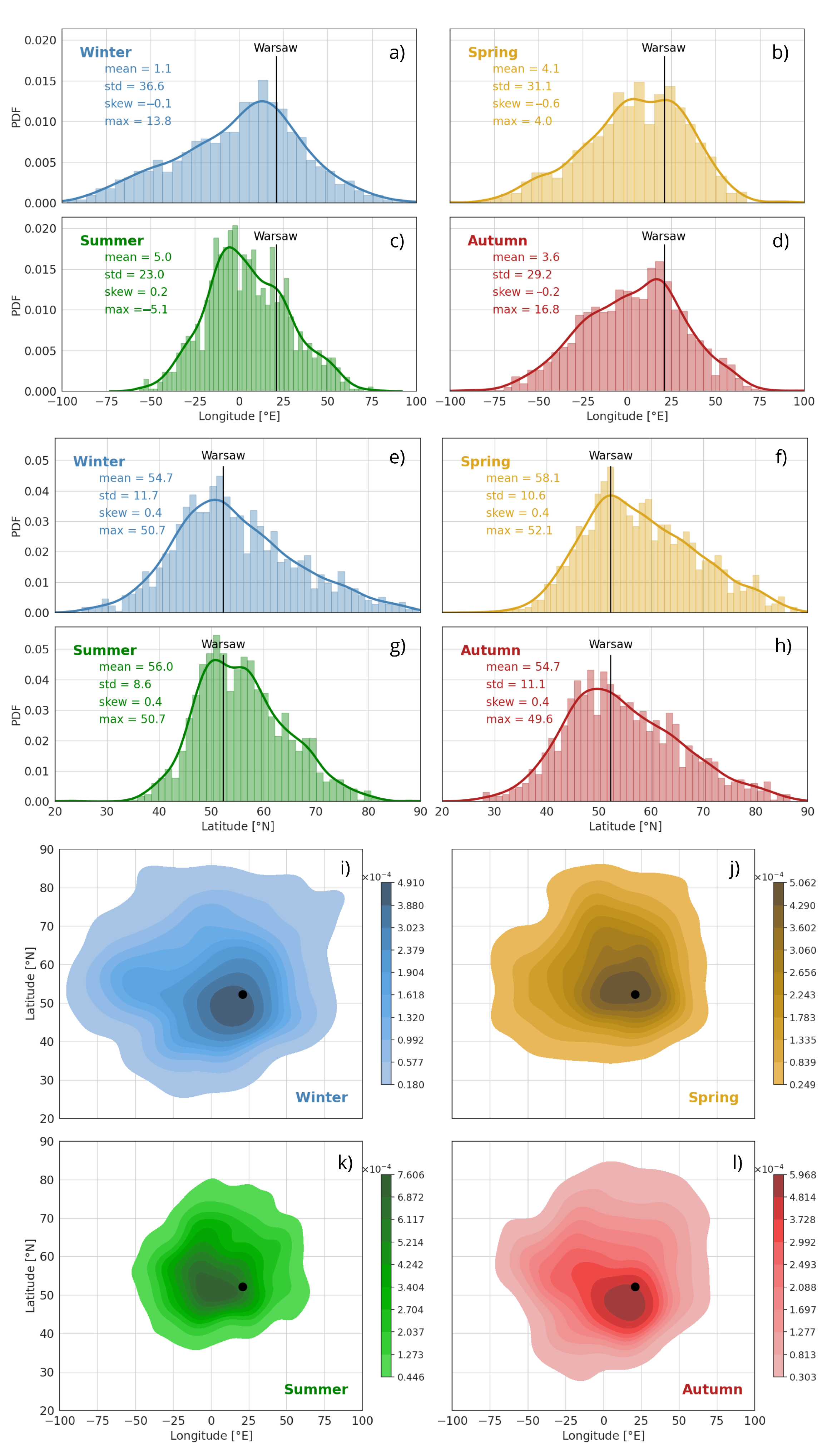


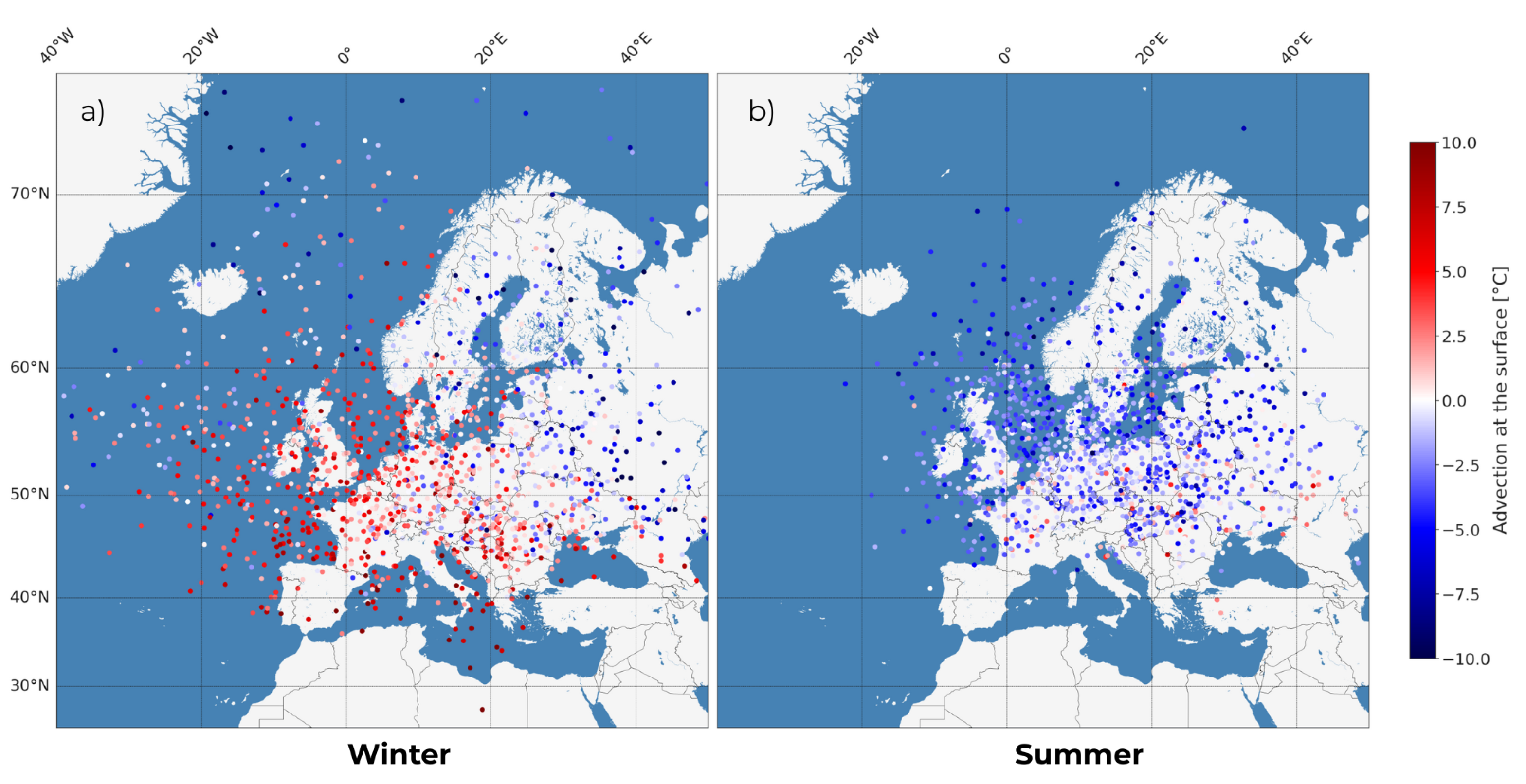
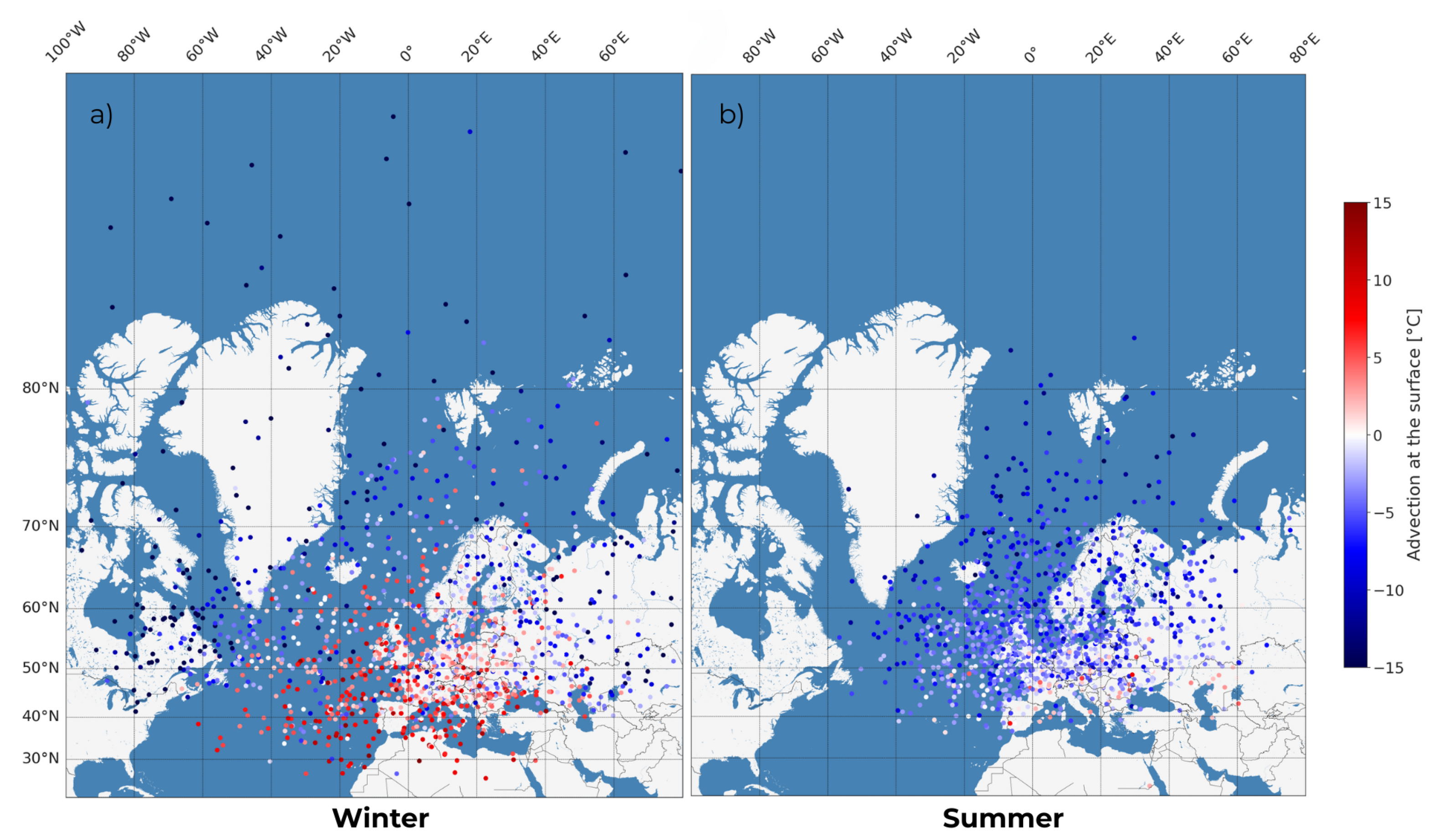
References
- IPCC. Contribution of Working Groups I, II and III to the Sixth Assessment Report of the Intergovernmental Panel on Climate Change. In Climate Change 2023: Synthesis Report; Core Writing Team, Lee, H., Romero, J., Eds.; IPCC: Geneva, Switzerland, 2023; pp. 35–115. [Google Scholar] [CrossRef]
- Wild, M. Global dimming and brightening: A review. J. Geophys. Res. Atmos. 2009, 114, D00D16. [Google Scholar] [CrossRef]
- Stamatis, M.; Hatzianastassiou, N.; Korras-Carraca, M.; Matsoukas, C.; Wild, M.; Vardavas, I. How strong are the links between global warming and surface solar radiation changes? Clim. Chang. 2024, 177, 156. [Google Scholar] [CrossRef]
- Kulesza, K. Influence of Air Mass Advection on the Amount of Global Solar Radiation Reaching the Earth’s Surface in Poland, Based on the Analysis of Backward Trajectories (1986–2015). Meteorology 2023, 2, 37–51. [Google Scholar] [CrossRef]
- Schilliger, L.; Tetzlaff, A.; Bourgeois, Q.; Correa, L.; Wild, M. An Investigation on Causes of the Detected Surface Solar Radiation Brightening in Europe Using Satellite Data. J. Geophys. Res. Atmos. 2024, 129, e2024JD041101. [Google Scholar] [CrossRef]
- Markowicz, K.; Zawadzka-Manko, O.; Posyniak, M. A large reduction of direct aerosol cooling over Poland in the last decades. Int. J. Climatol. 2022, 42, 4129–4146. [Google Scholar] [CrossRef]
- Markowicz, K.; Okraska, I.; Chilinski, M.; Makuch, P.; Nurowska, K.; Posyniak, M.; Rozwadowska, A.; Sobolewski, P.; Zawadzka-Manko, O. Long-term variability of the MERRA-2 radiation budget over Poland in Central Europe. Acta Geophys. 2024, 72, 2907–2924. [Google Scholar] [CrossRef]
- Wild, M. Enlightening global dimming and brightening. Bull. Am. Meteorol. Soc. 2012, 93, 27–37. [Google Scholar] [CrossRef]
- Sánchez-Lorenzo, A.; Wild, M. Decadal variations in estimated surface solar radiation over Switzerland since the late 19th century. Atmos. Chem. Phys. 2012, 12, 8635–8644. [Google Scholar] [CrossRef]
- Pfeifroth, U.; Sánchez-Lorenzo, A.; Manara, V.; Trentmann, J.; Hollmann, R. Trends and Variability of Surface Solar Radiation in Europe Based on Surface- and Satellite-Based Data Records. J. Geophys. Res. Atmos. 2018, 123, 1735–1754. [Google Scholar] [CrossRef]
- Wild, M.; Folini, D.; Henschel, F.; Fischer, N.; Müller, B. Projections of long-term changes in solar radiation based on CMIP5 climate models and their influence on energy yields of photovoltaic systems. Sol. Energy 2015, 116, 12–24. [Google Scholar] [CrossRef]
- Buras, A.; Rammig, A.; Zang, C. Quantifying impacts of the 2018 drought on European ecosystems in comparison to 2003. Biogeosciences 2020, 17, 1655–1672. [Google Scholar] [CrossRef]
- Falarz, M.; Małarzewski, L.; Uscka-Kowalkowska, J.; Matuszko, D.; Budzik, T. Solar Radiation Change. In Climate Change in Poland: Past, Present, Future; Springer International Publishing: Cham, Switzerland, 2021; pp. 177–188. [Google Scholar] [CrossRef]
- Chiacchio, M.; Wild, M. Influence of NAO and clouds on long-term seasonal variations of surface solar radiation in Europe. J. Geophys. Res. Atmos. 2010, 115, D00D22. [Google Scholar] [CrossRef]
- Bartoszek, K. The main characteristics of atmospheric circulation over East-Central Europe from 1871 to 2010. Meteorol. Atmos. Phys. 2017, 129, 113–129. [Google Scholar] [CrossRef]
- Niedźwiedź, T.; Ustrnul, Z. Change of Atmospheric Circulation. In Climate Change in Poland: Past, Present, Future; Springer International Publishing: Cham, Switzerland, 2021; pp. 123–150. [Google Scholar] [CrossRef]
- Kulesza, K. Spatiotemporal variability and trends in global solar radiation over Poland based on satellite-derived data (1986–2015). Int. J. Climatol. 2020, 40, 6526–6543. [Google Scholar] [CrossRef]
- Twardosz, R.; Bielec-Bakowska, Z. Continental-scale monthly thermal anomalies in Europe during the years 1951-2018 and their occurrence in relation to atmospheric circulation. Geogr. Pol. 2022, 95, 97–116. [Google Scholar] [CrossRef]
- Bogawski, P.; Bednorz, E. Atmospheric conditions controlling extreme summertime evapotranspiration in Poland (central Europe). Nat. Hazards 2016, 81, 55–69. [Google Scholar] [CrossRef]
- Owczarek, M. The influence of air temperature diversity in Central Europe on the occurrence of very strong and extreme cold stress in Poland in winter months. Geogr. Pol. 2021, 94, 251–266. [Google Scholar] [CrossRef]
- Nygård, T.; Papritz, L.; Naakka, T.; Vihma, T. Cold wintertime air masses over Europe: Where do they come from and how do they form? Weather Clim. Dyn. 2023, 4, 943–961. [Google Scholar] [CrossRef]
- Blazejczyk, K.; Twardosz, R.; Walach, P.; Czarnecka, K.; Blazejczyk, A. Heat strain and mortality effects of prolonged central European heat wave—an example of June 2019 in Poland. Int. J. Biometeorol. 2022, 66, 149–161. [Google Scholar] [CrossRef]
- Ustrnul, Z.; Wypych, A.; Czekierda, D. Air Temperature Change. In Climate Change in Poland: Past, Present, Future; Springer International Publishing: Cham, Switzerland, 2021; pp. 275–330. [Google Scholar] [CrossRef]
- Kundzewicz, Z.; Matczak, P. Climate change regional review: Poland. WIREs Clim. Change 2012, 3, 297–311. [Google Scholar] [CrossRef]
- Szyga-Pluta, K. Large Day-to-Day Variability of Extreme Air Temperatures in Poland and Its Dependency on Atmospheric Circulation. Atmosphere 2021, 12, 80. [Google Scholar] [CrossRef]
- Jędruszkiewicz, J.; Wibig, J. General Overview of the Potential Effect of Extreme Temperature Change on Society and Economy in Poland in the 21st Century. Geofizika 2019, 36, 131–152. [Google Scholar] [CrossRef]
- Tomczyk, A.; Bednorz, E.; Półrolniczak, M.; Kolendowicz, L. Strong heat and cold waves in Poland in relation with the large-scale atmospheric circulation. Theor. Appl. Clim. 2019, 137, 1909–1923. [Google Scholar] [CrossRef]
- Trigo, R.; Osborn, T.; Corte-Real, J. The North Atlantic Oscillation influence on Europe: Climate impacts and associated physical mechanisms. Clim. Res. 2002, 20, 9–17. [Google Scholar] [CrossRef]
- Falarz, M. Climate Change in Poland: Past, Present, Future; Springer International Publishing: Cham, Switzerland, 2021. [Google Scholar]
- ISO 9060:2018; Solar Energy—Specification and Classification of Instruments for Measuring Hemispherical Solar and Direct Solar Radiation. ISO: Geneva, Switzerland, 2018.
- Markowicz, K.M.; Stachlewska, I.S.; Zawadzka-Manko, O.; Wang, D.; Kumala, W.; Chilinski, M.T.; Makuch, P.; Markuszewski, P.; Rozwadowska, A.K.; Petelski, T.; et al. A Decade of Poland-AOD Aerosol Research Network Observations. Atmosphere 2021, 12, 1583. [Google Scholar] [CrossRef]
- NOAA. HYSPLIT Trajectory Model. 2025. Available online: https://www.ready.noaa.gov/HYSPLIT_traj.php (accessed on 15 January 2025).
- Stein, A.; Draxler, R.; Rolph, G.; Stunder, B.; Cohen, M.; Ngan, F. NOAA’s HYSPLIT Atmospheric Transport and Dispersion Modeling System. Bull. Am. Meteorol. Soc. 2015, 96, 2059–2077. [Google Scholar] [CrossRef]
- NCEI, NOAA. Global Data Assimilation System (GDAS). DOC/NOAA/NWS/NCEP/EMC > Environmental Modeling Center, National Centers for Environmental Prediction, National Weather Service, NOAA, U.S. Department of Commerce. 2025. Available online: https://www.ncei.noaa.gov/access/metadata/landing-page/bin/iso?id=gov.noaa.ncdc:C00379 (accessed on 18 February 2025).
- Hersbach, H.; Bell, B.; Berrisford, P.; Hirahara, S.; Horányi, A.; Muñoz-Sabater, L.; Nicolas, J.; Peubey, C.; Radu, R.; Schepers, D.; et al. The ERA5 global reanalysis. Q. J. R. Meteorol. Soc. 2020, 146, 1999–2049. [Google Scholar] [CrossRef]
- Copernicus Climate Change Service (C3S). ERA5: Fifth Generation of ECMWF Atmospheric Reanalyses of the Global Climate. Copernicus Climate Change Service Climate Data Store (CDS). 2017. Available online: https://cds.climate.copernicus.eu/cdsapp#!/home (accessed on 18 February 2025).
- ECMWF. ERA5 Hourly Data on Single Levels from 1940 to Present. 2025. Available online: https://cds.climate.copernicus.eu/datasets/reanalysis-era5-single-levels?tab=download (accessed on 15 January 2025).
- Cutler, A.; Cutler, D.; Stevens, J. Random Forests. In Ensemble Machine Learning: Methods and Applications; Springer: New York, NY, USA, 2011; Volume 45, pp. 157–176. [Google Scholar] [CrossRef]
- Breiman, L. Random Forest. Mach. Learn. 2001, 45, 5–32. [Google Scholar] [CrossRef]
- Zawadzka-Manko, O.; Markowicz, K. Long-Term Variability of Fog in Poland. Int. J. Climatol. 2025, 45, e8784. [Google Scholar] [CrossRef]
- Tomczyk, A.; Szyga-Pluta, K.; Bednorz, E. Occurrence and synoptic background of strong and very strong frost in spring and autumn in Central Europe. Int. J. Biometeorol. 2020, 64, 55–70. [Google Scholar] [CrossRef]
- Bartoszek, K. Atmospheric Circulation Conditions During Spring Frosts in Southeastern Poland (1981–2023). Atmosphere 2025, 16, 409. [Google Scholar] [CrossRef]
- Matuszko, D.; Bartoszek, K.; Soroka, J. Long-term variability of cloud cover in Poland (1971–2020). Atmos. Res. 2022, 268, 106028. [Google Scholar] [CrossRef]
- Cohen, J.; Screen, J.; Furtado, J.; Barlow, M.; Whittleston, D.; Coumou, D.; Francis, J.; Dethloff, K.; Entekhabi, D.; Overland, J.; et al. Recent Arctic amplification and extreme mid-latitude weather. Nat. Geosci. 2014, 7, 627–637. [Google Scholar] [CrossRef]
- Kautz, L.A.; Martius, O.; Pfahl, S.; Pinto, J.G.; Ramos, A.M.; Sousa, P.M.; Woollings, T. Atmospheric blocking and weather extremes over the Euro-Atlantic sector–A review. Weather Clim. Dyn. 2022, 3, 305–336. [Google Scholar] [CrossRef]
- Jędruszkiewicz, J.; Wibig, J.; Piotrowski, P. Cold Waves in Poland: The Relations to Atmospheric Circulation and Arctic Warming. Int. J. Climatol. 2025, 45, e8813. [Google Scholar] [CrossRef]
- Krüger, J.; Kjellsson, J.; Kedzierski, R.; Claus, M. Connecting North Atlantic SST Variability to European Heat Events over the Past Decades. Tellus A Dyn. Meteorol. Oceanogr. 2023, 75, 358–374. [Google Scholar] [CrossRef]
- Tang, Q.; Leng, G.; Groisman, P. European Hot Summers Associated with a Reduction of Cloudiness. J. Clim. 2012, 25, 3637–3644. [Google Scholar] [CrossRef]
- Tomczyk, A.; Bednorz, E. Heat waves in Central Europe and their circulation conditions. Int. J. Climatol. 2016, 36, 770–782. [Google Scholar] [CrossRef]
- Jędruszkiewicz, J.; Wibig, J.; Piotrowski, P. Heat waves in Poland: The relations to atmospheric circulation and Arctic warming. Int. J. Climatol. 2024, 44, 2189–2206. [Google Scholar] [CrossRef]
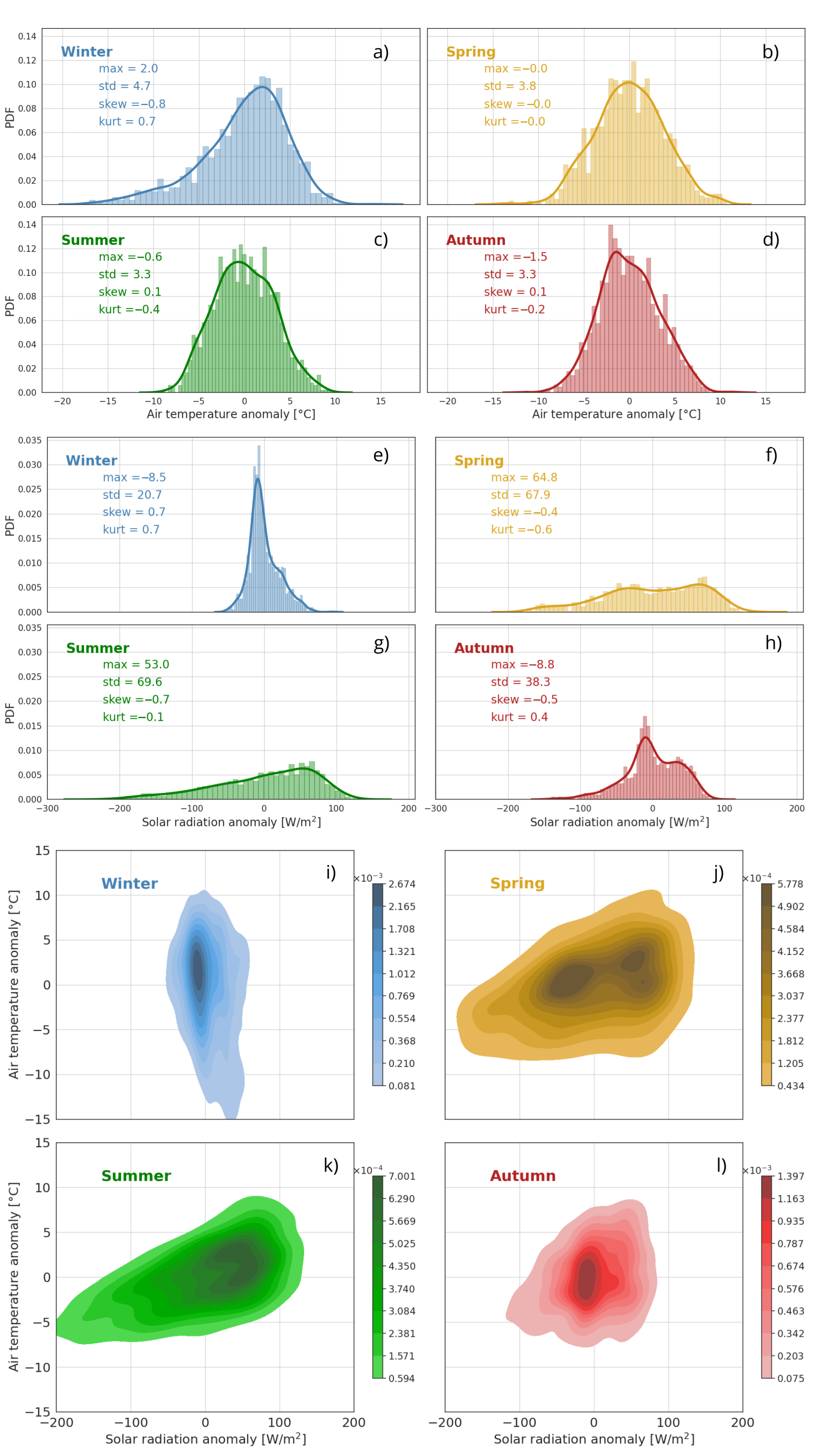
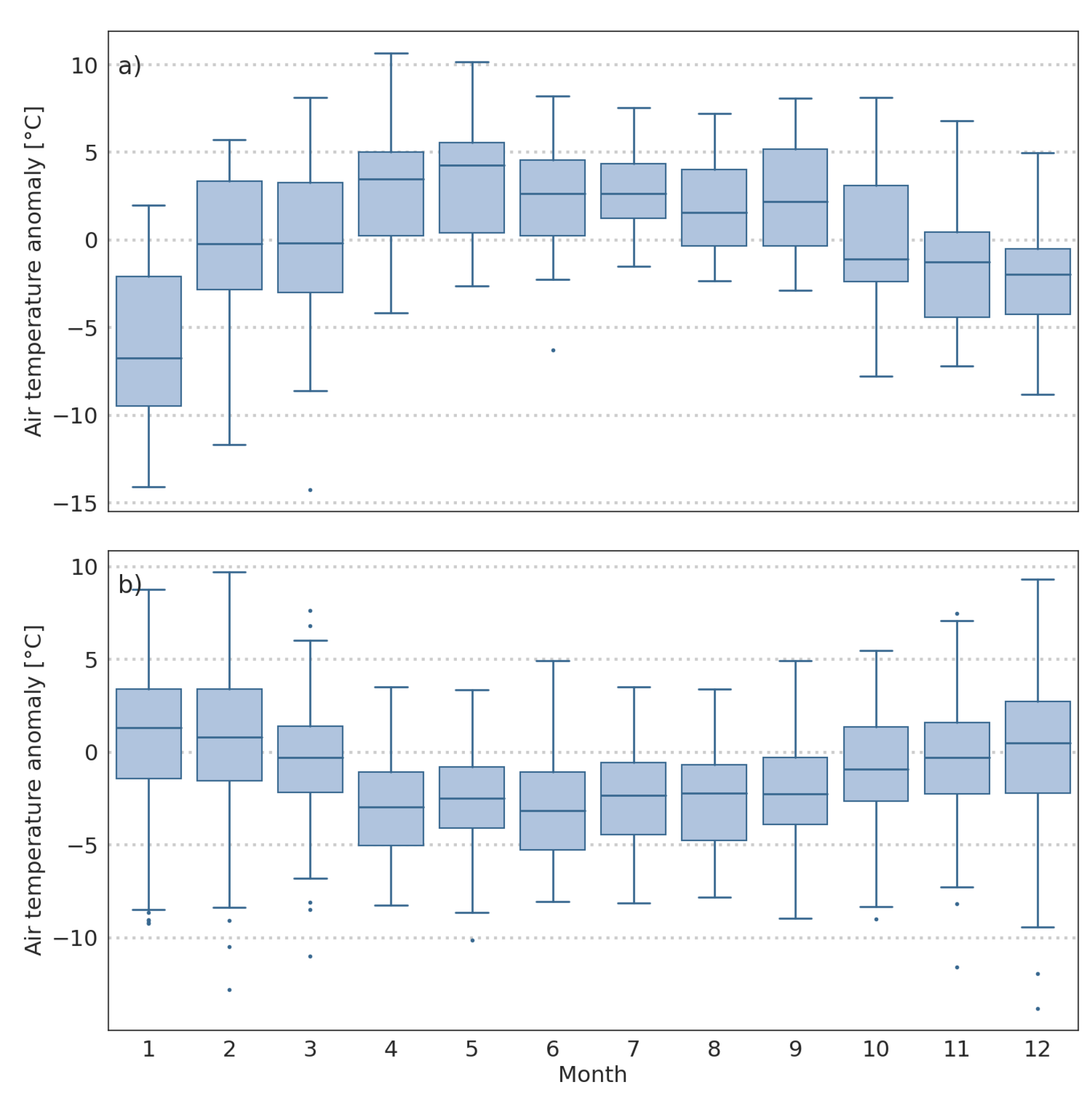
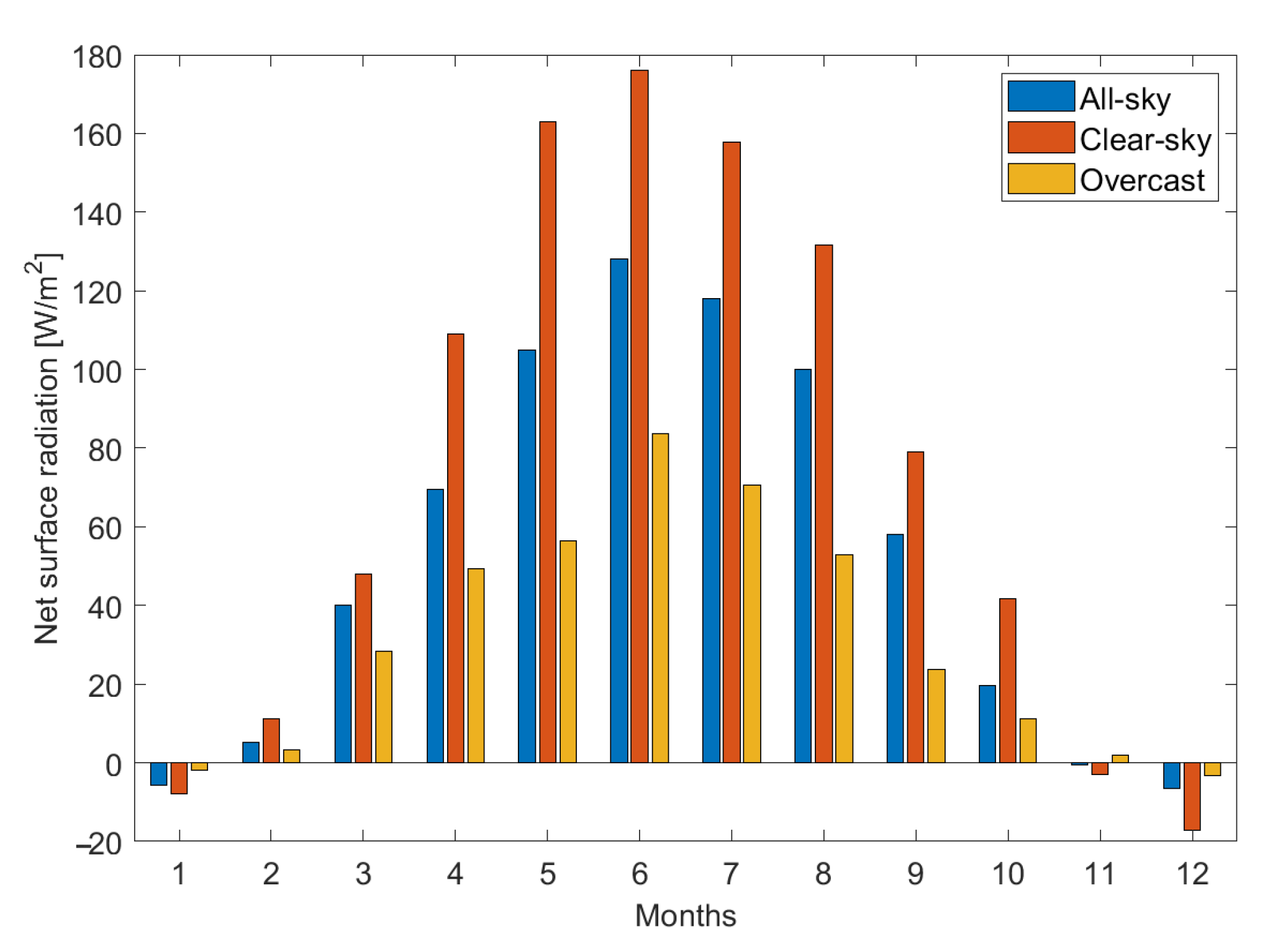
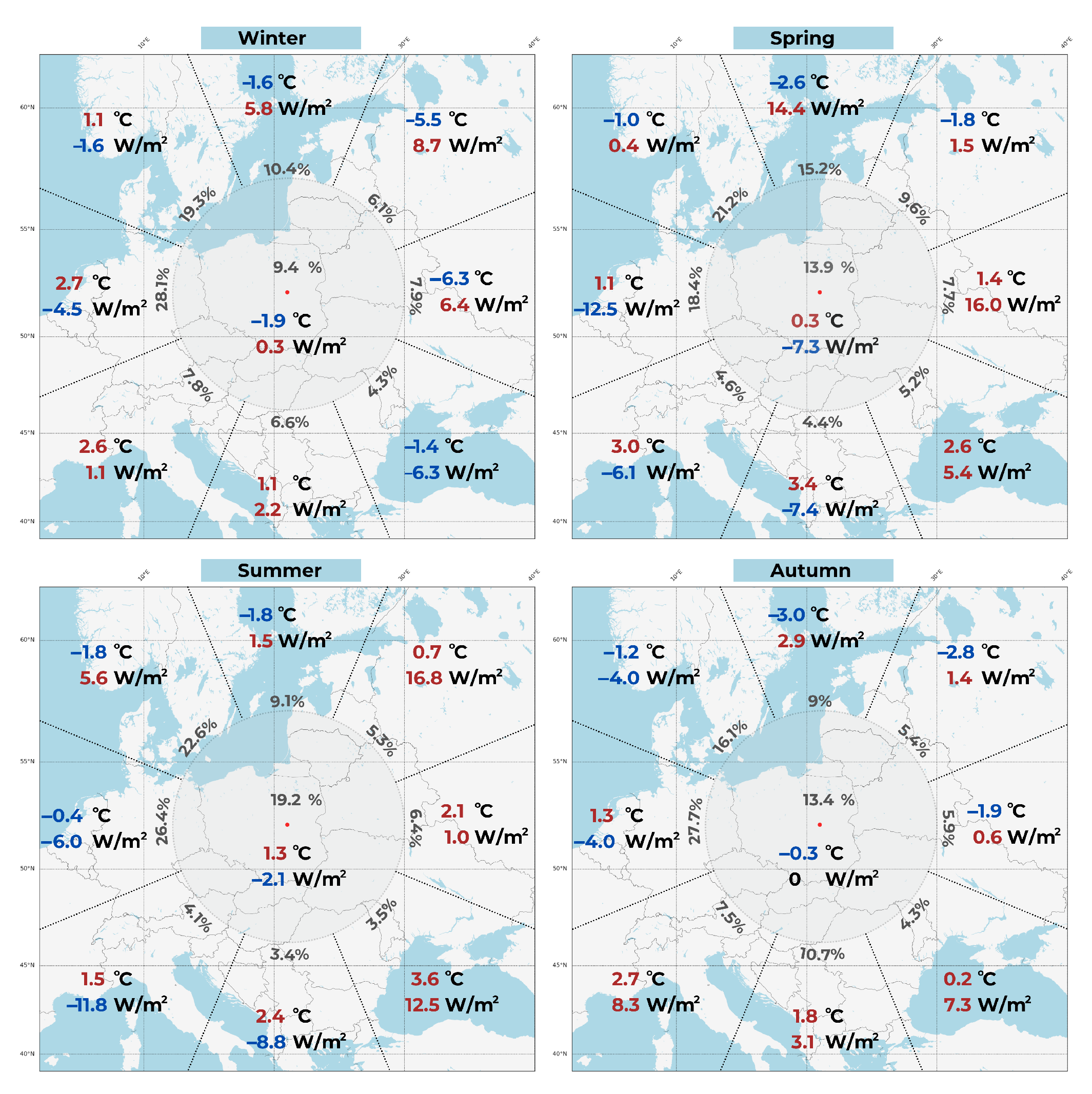
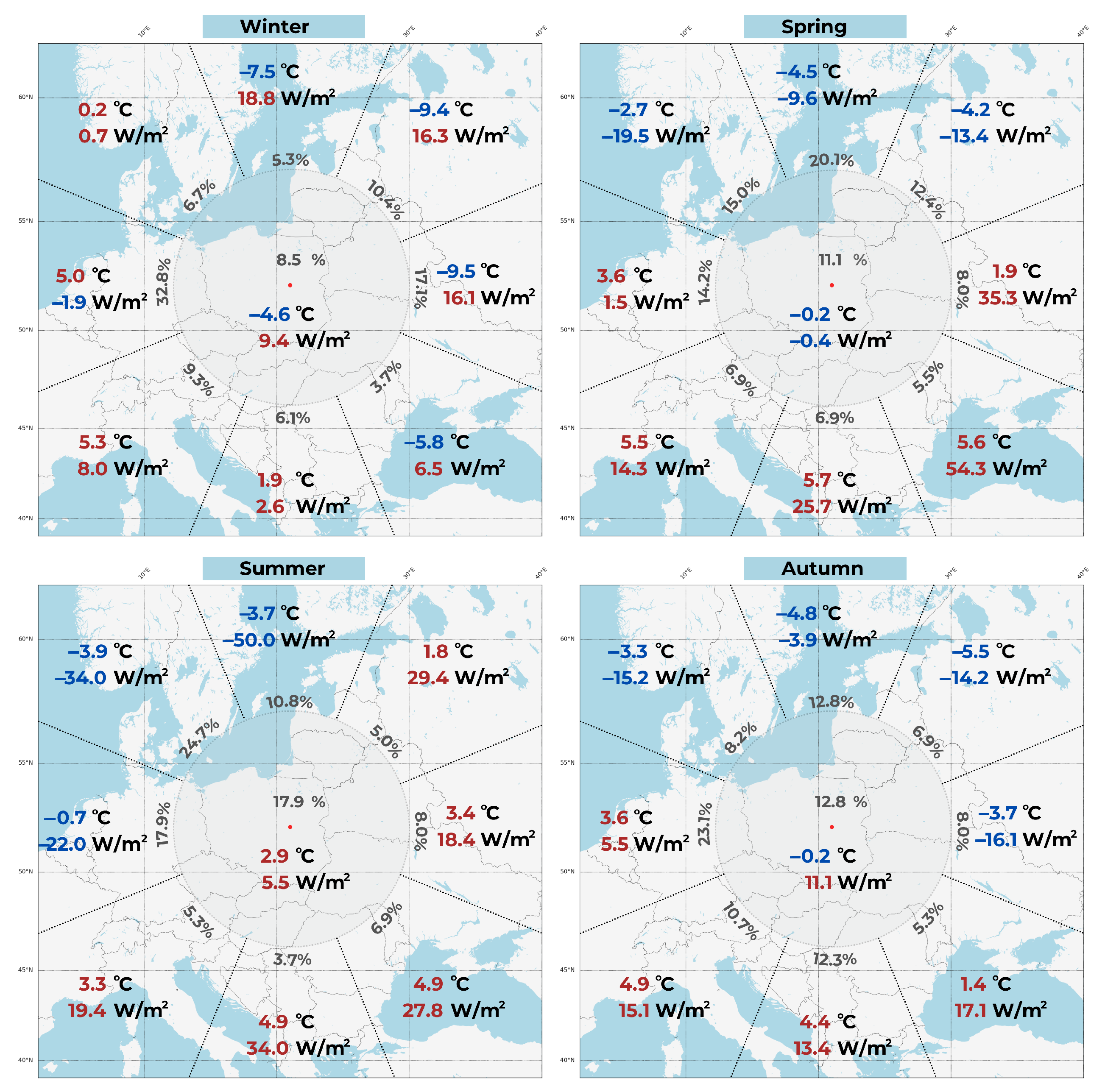
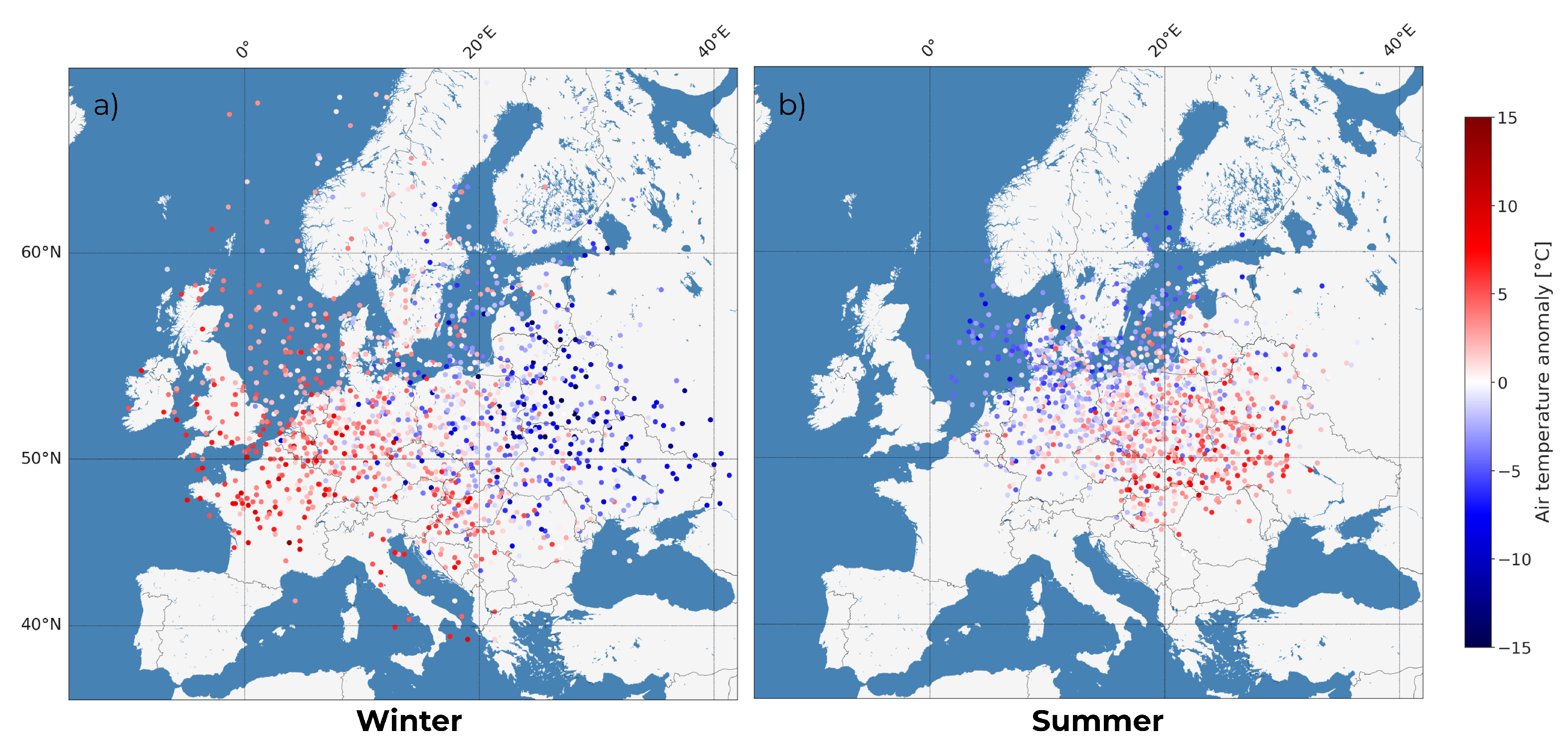
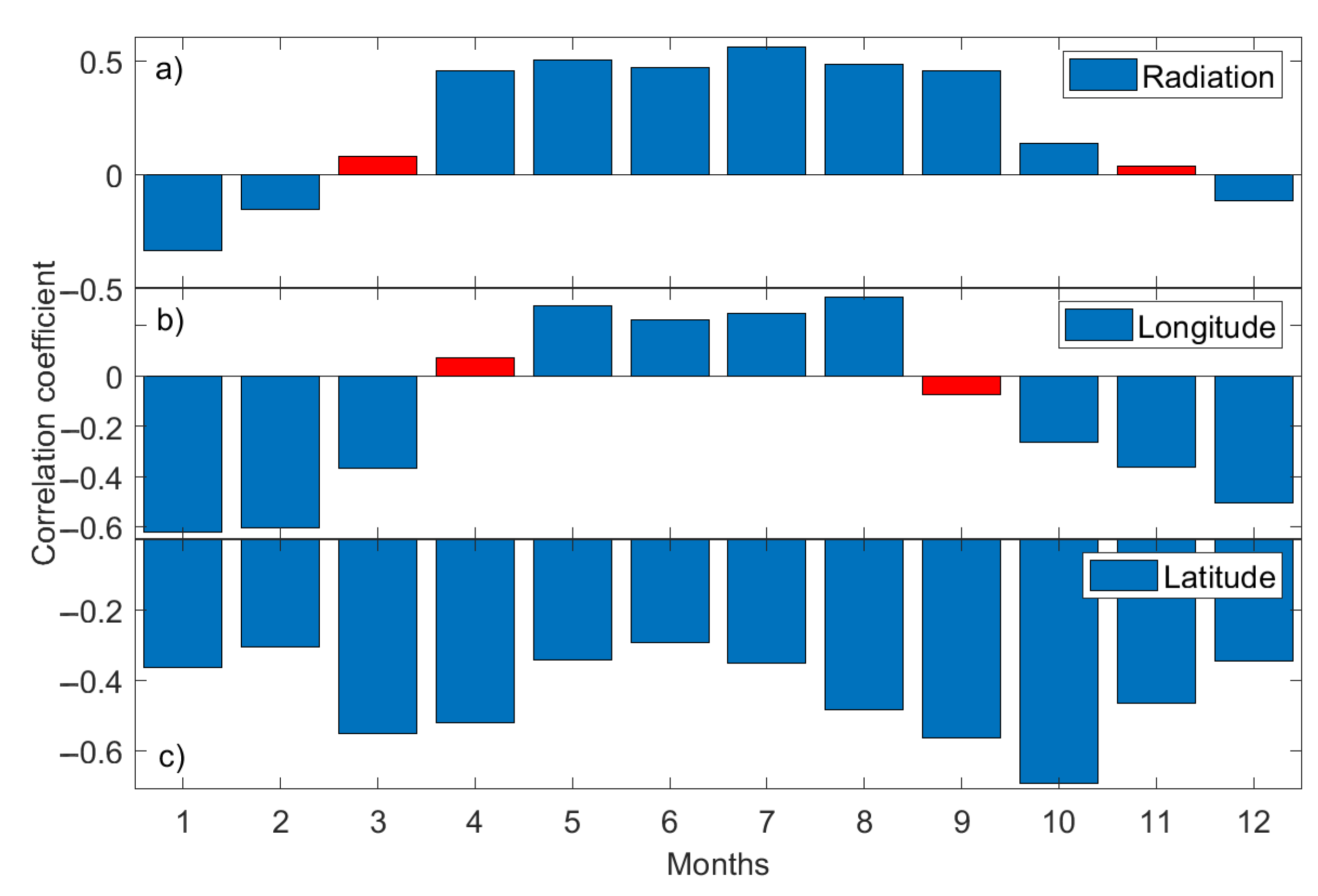

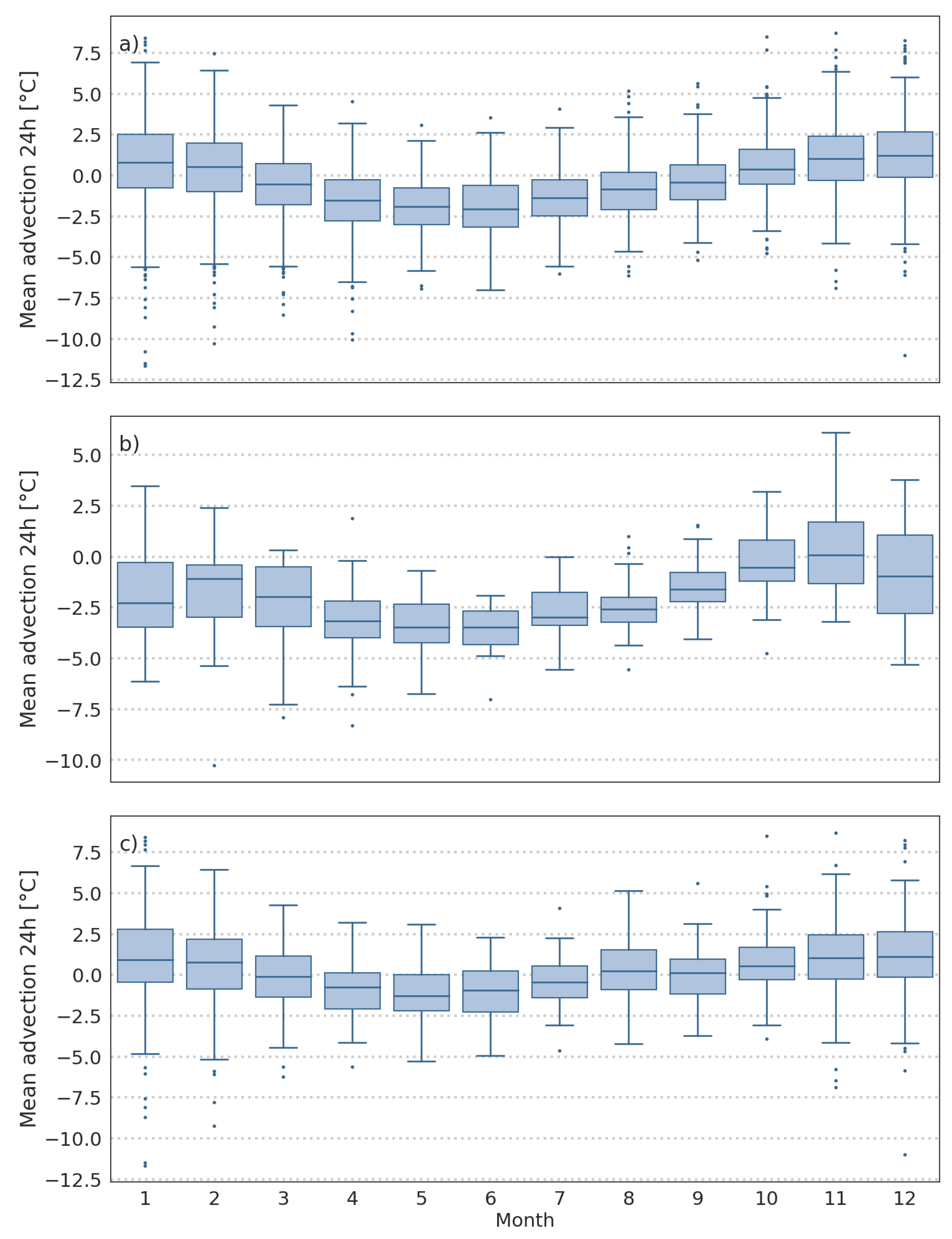
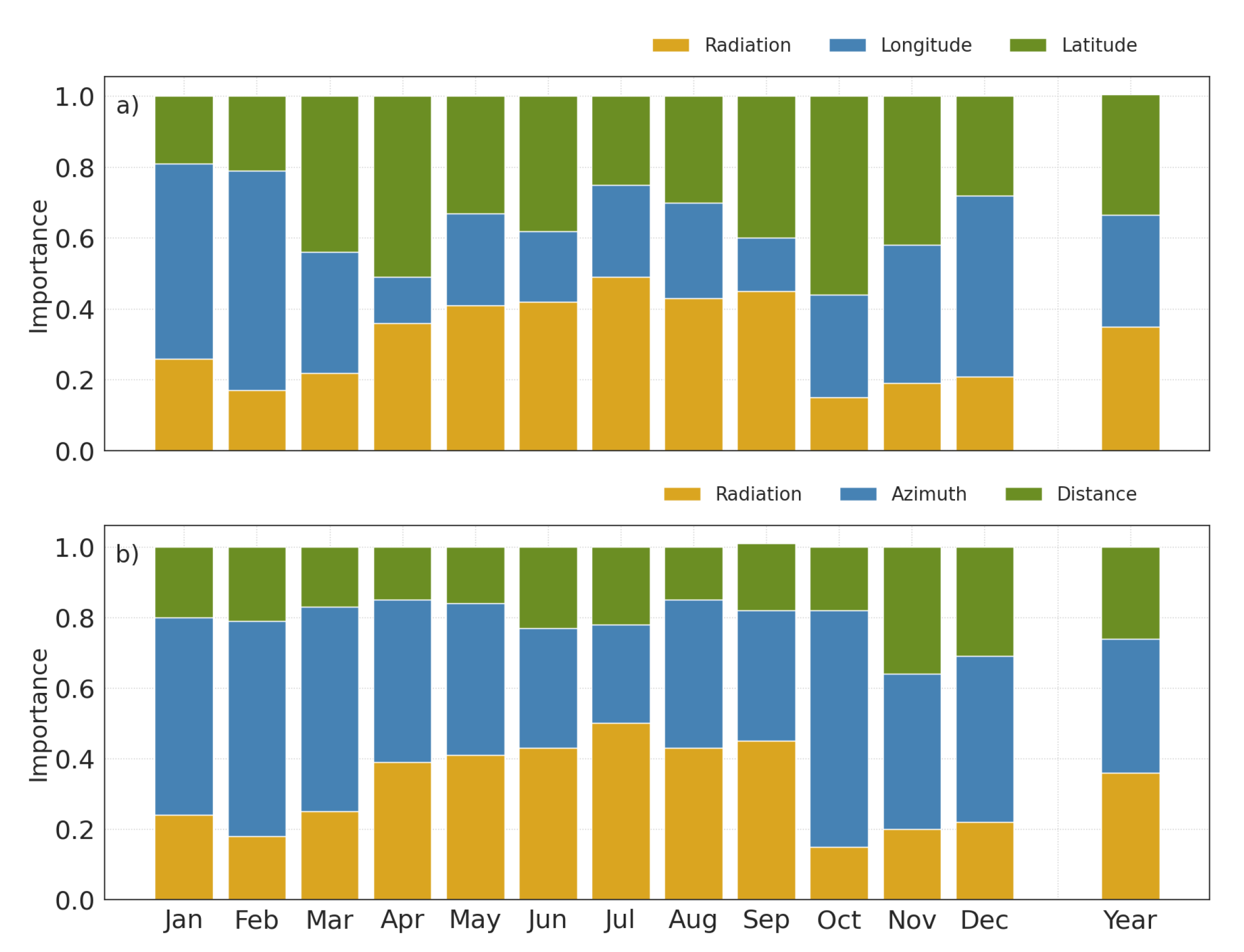
| Direction | Winter | Spring | Summer | Autumn | ||||
|---|---|---|---|---|---|---|---|---|
| all | >1 | all | >1 | all | >1 | all | >1 | |
| <500 km | −0.38 | −0.63 | 0.59 | 0.63 | 0.58 | 0.76 | 0.40 | 0.58 |
| N | −0.16 | (−0.24) | 0.43 | (0.17) | 0.60 | 0.55 | (0.12) | (0.09) |
| NE | −0.36 | −0.42 | 0.38 | (0.18) | 0.51 | 0.66 | 0.35 | (0.1) |
| E | −0.60 | −0.43 | 0.44 | 0.65 | 0.69 | 0.84 | 0.30 | (0.26) |
| SE | −0.35 | (−0.45) | 0.73 | (0.26) | 0.70 | 0.54 | 0.33 | 0.49 |
| S | (0.11) | (−0.05) | 0.67 | (0.14) | 0.80 | (0.44) | 0.41 | 0.5 |
| SW | (−0.08) | (−0.08) | 0.52 | 0.47 | 0.84 | 0.58 | 0.35 | 0.62 |
| W | (0.03) | (−0.08) | 0.36 | 0.52 | 0.57 | 0.82 | 0.27 | (0.18) |
| NW | −0.16 | (−0.33) | 0.39 | 0.55 | 0.57 | 0.55 | 0.13 | 0.33 |
| Mean | −0.24 | −0.3 | 0.50 | 0.4 | 0.65 | 0.64 | 0.29 | 0.35 |
| Winter | Spring | Summer | Autumn | Annual | ||
|---|---|---|---|---|---|---|
| All cases | Mean | 0.7 | −1.4 | −1.4 | 0.4 | −0.4 |
| Std | 2.6 | 2.0 | 1.8 | 1.9 | 2.1 | |
| Skew | −0.6 | −0.3 | 0.1 | 0.4 | −0.1 | |
| Kurt | 1.8 | 0.5 | 0.0 | 1.0 | 0.8 | |
| Clear sky | Mean | −1.5 | −3.0 | −2.9 | −0.6 | −2.0 |
| Std | 2.8 | 1.9 | 1.4 | 1.8 | 2.0 | |
| Skew | −0.4 | −0.3 | 0.3 | 0.9 | 0.1 | |
| Kurt | 0.7 | 0.0 | 1.0 | 1.2 | 7.3 | |
| Overcast | Mean | 0.9 | −0.6 | −0.3 | 0.7 | 0.2 |
| Std | 2.6 | 1.8 | 1.8 | 1.9 | 2.0 | |
| Skew | −0.7 | −0.1 | 0.2 | 0.2 | −0.1 | |
| Kurt | 2.7 | 0.1 | 0.4 | 1.6 | 1.2 |
| Winter | Spring | Summer | Autumn | ||
|---|---|---|---|---|---|
| Radiation | −2 | 25.7 ± 19.5 | −4.9 ± 70.3 | −136.3 ± 57.6 | −13.5 ± 44.0 |
| +2 | 6.1 ± 20.6 | 48.1 ± 40.4 | 64.3 ± 21.5 | 35.2 ± 22.5 | |
| Longitude | −2 | 22.2 ± 11.2 | 16.7 ± 9.9 | −0.3 ± 13.3 | 19.8 ± 10.2 |
| +2 | −10.5 ± 11.0 | 1.3 ± 11.9 | 11.2 ± 8.4 | 0.3 ± 13.0 | |
| Latitude | −2 | 1.2 ± 4.7 | 5.2 ± 6.1 | 6.5 ± 5.2 | 4.4 ± 5.0 |
| +2 | −7.7 ± 3.0 | −8.7 ± 2.9 | −4.1 ± 3.6 | −7.8 ± 4.7 |
| R2 Score | |||||||||||||
|---|---|---|---|---|---|---|---|---|---|---|---|---|---|
| Jan | Feb | Mar | Apr | May | Jun | Jul | Aug | Sep | Oct | Nov | Dec | Year | |
| Lon, Lat | 0.61 | 0.58 | 0.38 | 0.4 | 0.57 | 0.52 | 0.53 | 0.56 | 0.58 | 0.36 | 0.53 | 0.35 | 0.31 |
| Az, Dist | 0.61 | 0.62 | 0.39 | 0.44 | 0.56 | 0.51 | 0.52 | 0.54 | 0.53 | 0.35 | 0.51 | 0.35 | 0.31 |
| Correlation Coefficient | |||||||||||||
|---|---|---|---|---|---|---|---|---|---|---|---|---|---|
| Jan | Feb | Mar | Apr | May | Jun | Jul | Aug | Sep | Oct | Nov | Dec | Year | |
| U-wind | 0.7 | 0.69 | 0.39 | −0.12 | −0.31 | −0.31 | −0.35 | −0.41 | 0.01 | 0.35 | 0.45 | 0.59 | 0.19 |
| V-wind | 0.1 | 0.12 | 0.44 | 0.55 | 0.48 | 0.47 | 0.46 | 0.47 | 0.53 | 0.59 | 0.32 | 0.19 | 0.36 |
| Dist | 0.41 | 0.38 | 0.06 | −0.24 | −0.23 | −0.35 | −0.42 | −0.34 | −0.31 | 0.05 | 0.42 | 0.47 | 0.02 |
Disclaimer/Publisher’s Note: The statements, opinions and data contained in all publications are solely those of the individual author(s) and contributor(s) and not of MDPI and/or the editor(s). MDPI and/or the editor(s) disclaim responsibility for any injury to people or property resulting from any ideas, methods, instructions or products referred to in the content. |
© 2025 by the authors. Licensee MDPI, Basel, Switzerland. This article is an open access article distributed under the terms and conditions of the Creative Commons Attribution (CC BY) license (https://creativecommons.org/licenses/by/4.0/).
Share and Cite
Zawadzka-Mańko, O.; Markowicz, K.M. The Role of Air Mass Advection and Solar Radiation in Modulating Air Temperature Anomalies in Poland. Atmosphere 2025, 16, 820. https://doi.org/10.3390/atmos16070820
Zawadzka-Mańko O, Markowicz KM. The Role of Air Mass Advection and Solar Radiation in Modulating Air Temperature Anomalies in Poland. Atmosphere. 2025; 16(7):820. https://doi.org/10.3390/atmos16070820
Chicago/Turabian StyleZawadzka-Mańko, Olga, and Krzysztof M. Markowicz. 2025. "The Role of Air Mass Advection and Solar Radiation in Modulating Air Temperature Anomalies in Poland" Atmosphere 16, no. 7: 820. https://doi.org/10.3390/atmos16070820
APA StyleZawadzka-Mańko, O., & Markowicz, K. M. (2025). The Role of Air Mass Advection and Solar Radiation in Modulating Air Temperature Anomalies in Poland. Atmosphere, 16(7), 820. https://doi.org/10.3390/atmos16070820







